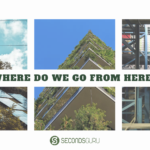Published 13 February 2023 ● Last Updated on 11 August 2023
The world population recently hit the 8 billion mark, yet humanity continues using up resources faster than Earth can replenish them. In order to preserve and protect the world against evermore depletion of resources, we need to rethink how we inhabit the world. With urbanisation only set to increase, we need sustainable cities – urban settlements that nourish the people and the planet.
Can you imagine a world with smog-free air, plenty of green spaces, cyclists crisscrossing the city, and pedestrians moving without having to jostle with cars? It is this utopian vision that some cities are aiming towards, to create benefits not only for today but also for the foreseeable future.
Let’s take a peek at what these cities are doing right.
Effective Waste Management
Urban waste is unavoidable, but city planning can play a pivotal role in ensuring proper and optimised disposal. By encouraging recycling and composting, cities can reap the benefits of a circular economy, while also reducing the stress on virgin resources.
Copenhagen, Denmark is a case in point – its efforts to increase recycling hit a high point of 92% for all bottles and cans in 2019. Citizens can recycle these items in the stores they shop from via reverse vending machines. As a result, Danes send less than 2% of their waste to landfills, and 40% is incinerated. This incineration in turn generates about 1 million megawatt hours of energy. Exemplifying this thrust of landfill-avoidance is CopenHill, a combined heat and power waste-to-energy plant that has a ski slope, hiking trail, and climbing wall on its roof!

Waste management is just one part of Copenhagen’s overall eco push – biking is a common mode of transport for most people, buses are going electric, additionally, the city employs water-powered boat taxis and solar-powered boats. This city announced its goal of becoming the first carbon-neutral city by 2025in 2019 and it is well on track to achieve it. From 2005-2011, it reduced its carbon emissions by 21%. No wonder Copenhagen is often referred to as the most sustainable city in the world.
Reducing Water Footprint
Water is essential to life. But because of its mismanagement, groundwater is depleting in most urban centres and access to safe water is no guarantee in many rural areas around the world.

Against this global backdrop, the story of Singapore serves as an admirable model. The small island nation has limited access to natural fresh water sources, and has been largely dependent on water imports to meet the demands of industry and its 5.6 million people. Understanding the value of water security, it has developed an integrated water management system that successfully closes the ‘water loop’.
Man-made reservoirs and storm drains create a network that maximise capture of freshwater for the island – the water catchment area now covers two-thirds of the country’s land surface. Five Desalination plants are in operation, with more in the pipeline. All used water is collected through a network of sewers – that’s right, we’re talking even sewage – to water reclamation plants, where it is treated to international standards stipulated by the U.S Environmental Protection Agency and World Health Organisation. The end result is potable water – with no drop left behind.
Powering the Up With Renewable Energy
While coal and other fossil fuels are the the prime sources of energy for most cities, there is a clear opportunity for sustainable cities to break from the pack.
Iceland has been extending its geothermal* energy system since 1930s, notes WWF, and today it makes up more than one-third of country’s total energy consumption. So it’s no surprise that they have the world’s largest geothermal heating system. It’s capital city Reykjavic is powered completely by geothermal because of which carbon dioxide emissions have been reduced by up to 110 million tons from 1944 to 2006. The system keeps 4 million tons of carbon dioxide out of the atmosphere every year.
*Extracting heat from the geothermal reservoirs from the Earth’s interior using wells or other means is called geothermal energy. This is a rather old and reliable system of energy supply that has been used for more than 100 years
De-carbonising Transport
Vehicles contribute to pollution and carbon emissions in cities across the world. What if we could mitigate this, with the use of pedal power? See this wishful thought in action at the cycling capital of the world: Amsterdam, Netherlands, which has 550,000 bicycles and 800,000 people. Biking here is safe, fun and convenient. So what is Amsterdam doing right?

Dedicated bike lanes are everywhere – not just on the principal streets, but on side streets, through city parks, and along the canals. It has 400 km of bike lanes and about 38% of all commuter trips are made by bike. Bike racks for parking are available everywhere, plus parking garages in central locations like the central train station. Bike rentals are aplenty and it’s easy to get yourself a bike, even as a tourist.
Providing Affordable and Attractive Mass Transit
With rapid urbanisation comes a pressing need to improve urban mobility, and sustainable cities are developing infrastructure to make mass transit a more attractive option for residents versus private vehicles.

A standout example is the bus rapid transit (BRT) in Bogotá, Colombia – The Bogotá Transmilenio system. BRT achieves the speed usually attributed to rail by operating on exclusive lanes separated from other traffic and by getting priority at intersections. It is also cheaper than rail by running at the road level (thus avoiding costs of tunneling and other logistical demands).
Bogotá’s BRT expanded to 207km of bus lanes in 2015, making it the largest BRT in the world. From 2013 to 2019, the annual average estimated reduction of CO₂ emissions amounts to 578,918 tCO₂eq which is equivalent to the emissions of around 123,174 cars per year. There are social benefits too: in the areas where TransMilenio operates, there has been a reduction of 92% in road related deaths, 75% in injuries and 79% in collisions. The result is a transport system that is very attractive for the urban residents.
Tapping On By-products
Waste is often treated as nothing more than a disposal problem. But sustainable cities recognise its value – from which electricity, fertiliser, fish food, and gasoline can be mined.
Stockholm is home to Värtaverket, Sweeden’s largest biofuel-powered combined heat and power (CHP) plant which produces enough energy to heat approximately 190,000 average-size apartments and charge 150,000 electric cars. It produces heat and electricity by combusting solid biomass, mainly residuals from the forest product industry – wooden chips, saw dust, branches and tops.

Sweden being a cold country, has had the tradition of district heating since the early 1950s. The Värtaverket plant has made it possible to supply fossil-free electricity, delivering an annual reduction in CO2 emissions of 126,000 tonnes. This ensures air in the Swedish capital is among the cleanest of any city in the world.
Greening Urban Spaces
As urban spaces expand, the green cover of a city is often the first to give way to buildings. The lopsided approach to development divorces people from nature while creating urban heat oases. Cities are now understanding the urgent need to address this issue and have resorted to planned green spaces.

Curitiba, listed as Brazil’s greenest city now, boasts more than 1,000 oases of green space. Challenged with a large population, Curitiba has been working towards a sustainable green city model since the 70s. City planners have been adding natural leisure areas and incentivising recycling as part of city planning.
The local government put an afforestation plan in place that saw the planting of trees on the roadsides, in parks, squares, and other public areas. 139,000 trees were planted between 2013 and 2016. While the native species are favoured, for roadside planting, larger trees are seen in the parks and squares. Ten mini-forests have also been established, using smaller areas where larger plantations are impossible.
Proactively Planning For Flooding by Making Room For Rivers
Climate change and unplanned urban development have resulted in major disasters worldwide, but some countries have bounced back with strong action plans that have seen great results.
The Netherlands is located in a delta of three major rivers, the Rhine, Meuse, and Scheldt, and hence is vulnerable to flooding. Nearly 30% of the country lies below sea level and another 30% along its rivers. In 1993 and 1995, the rivers flooded to unprecedented levels, leading to the evacuation of 250,000 people and 1 million farm animals.

Recognising that climate change will escalate flood risks, the country takes a proactive approach to tackle flooding and has adopted a national strategy called the Delta Program. One of this programme’s initiatives, Room for the River is a €2.3 billion program to restore the rivers’ natural flood plains. It creates more room for floodwaters by removing silt, creating diversions to redirect excess river water, and restoring marshy riverine landscapes in 30 locations across the country.
What does it mean to be a sustainable city?
A sustainable city is one designed to address social, environmental, and economic impact through urban planning. Sustainable initiatives can be achieved by embedding eco-friendly alternatives into city infrastructure. While sustainability is essential to the planet, reducing costs and creating a vibrant culture for citizens are also equally important. Cities can leave behind a net zero footprint through planned infrastructure, public green spaces, smart waste removal, and many other green measures.
Related Links
Solar Energy | Sembcorp has more than the Tengeh Floating Platform on its agenda



0 Comments